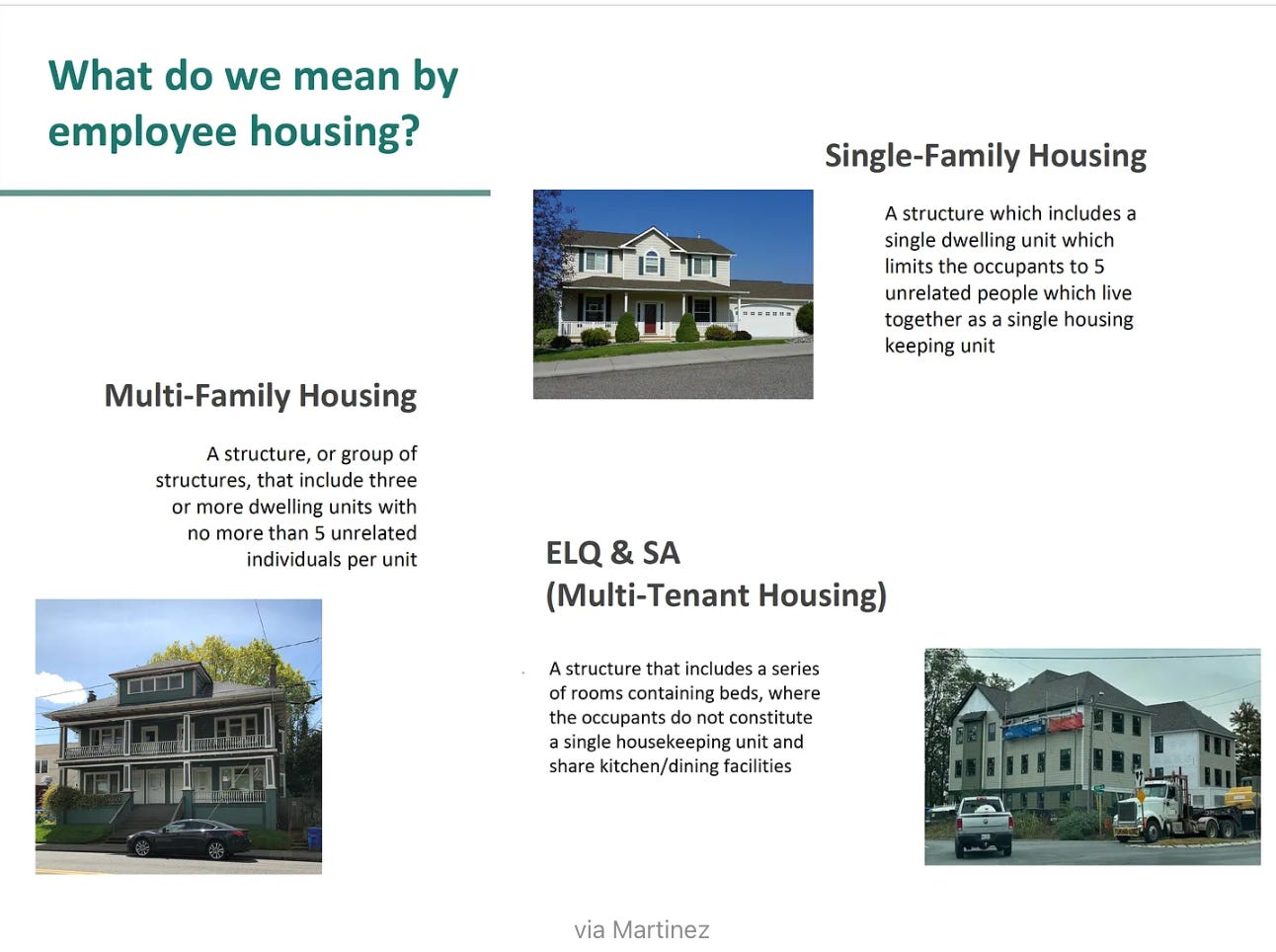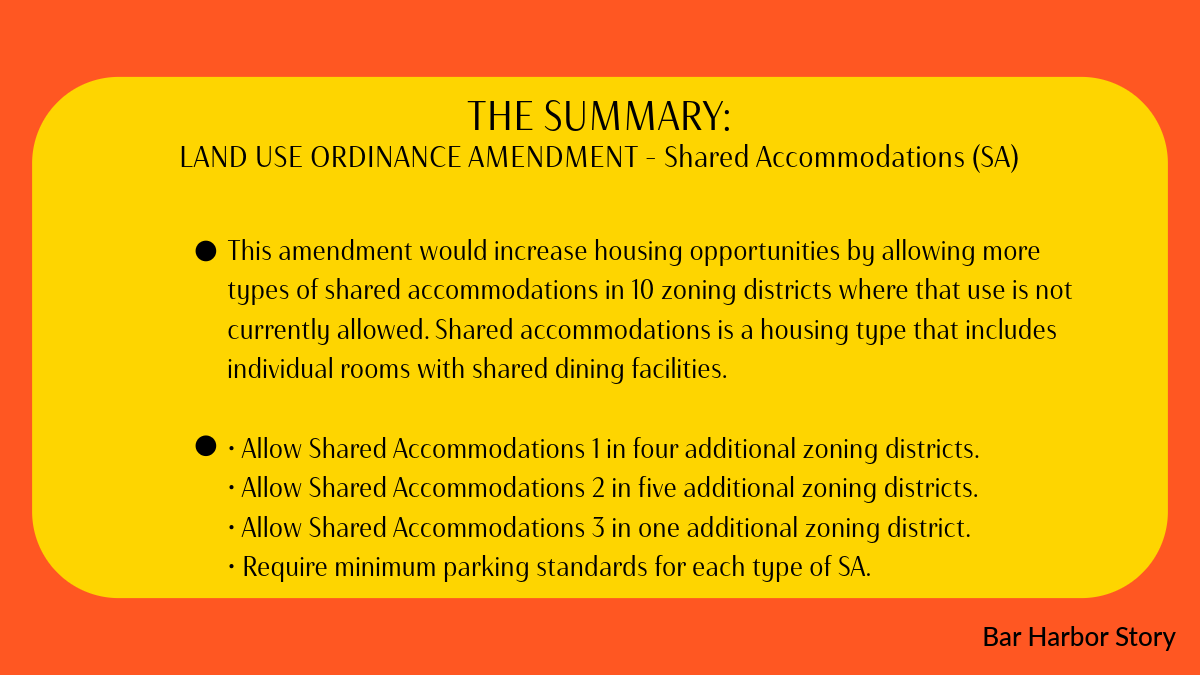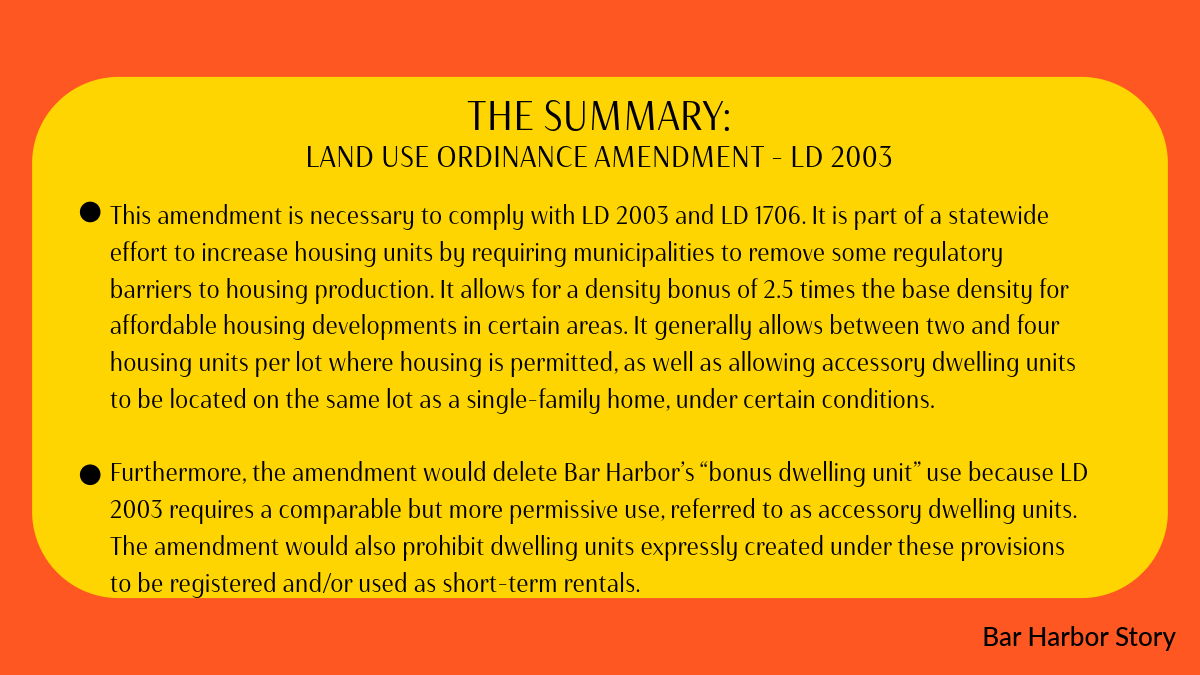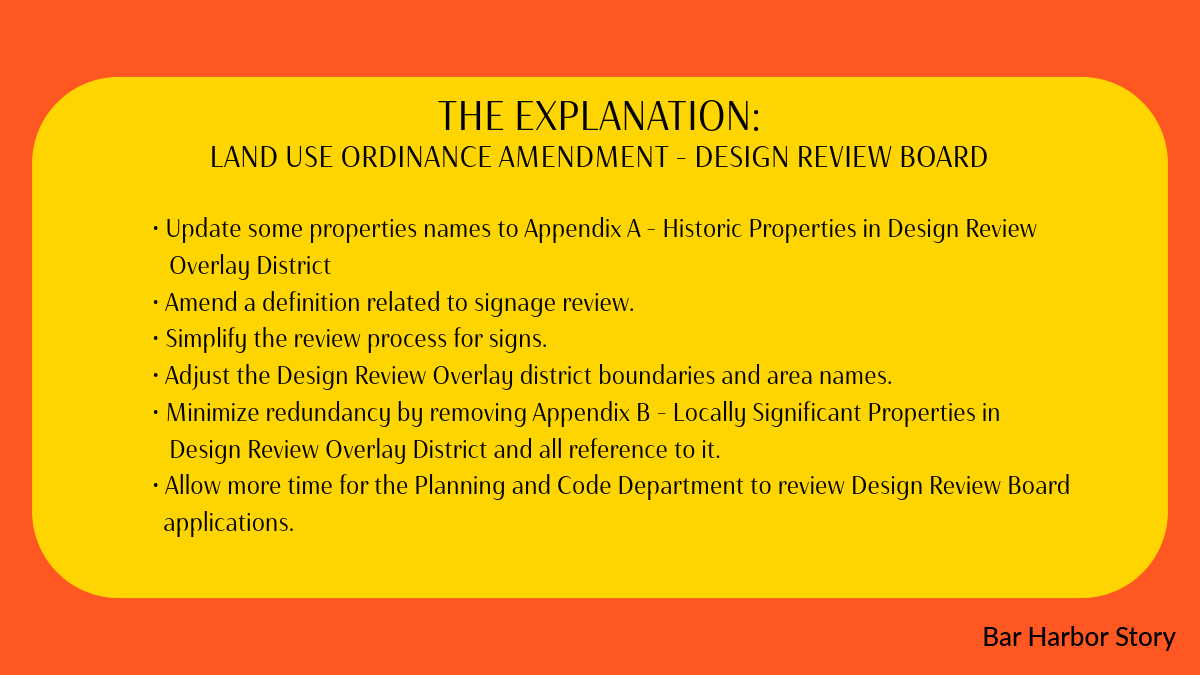Building Between a Ledge and A Wet Place
Potential Housing Amendments Move To Town Council Amid Some Town Hill Residents' Worries
BAR HARBOR—Concerns about water use, sewer capacities, and nitrates as well as the re-purposing of potential employee living quarters in many zoning districts dominated the Planning Board’s public hearing on Wednesday, June 3, about multiple potential land use ordinance amendments that deal with adding specific types of housing uses in different areas in town.
The marathon meeting lasted almost three hours due to extensive public comment. Much of that comment came from Stewart Brecher, Dessa Dancy, Ellen Grover, and Diane Vreeland, who spoke on many of the four proposed amendments. Others spoke as well. Over a dozen members of the public attended in person and via Zoom. Vice Chair Ruth Eveland led the meeting with members Cosmo Nims and J. Clark Stivers also attending in person. Secretary Elissa Chesler, Joseph Cough, and Zach Soares attended via Zoom.
HOW THE PROCESS WORKS
The volunteer Planning Board and town’s Planning Department have been working for months on three of the proposed amendments to the town’s Land Use Ordinance. The town’s volunteer Design Review Board has been working on another proposed amendment.
The town’s Land Use Ordinance creates the rules for development for the town.
Any change to that ordinance would have to be approved by the voters in June 2024.
On Wednesday night, in four separate votes, the Planning Board unanimously voted to move the potential amendments to the Town Council where councilors will consider the amendments. Unlike the Planning Board, the Council can make changes to the amendments and their wording. The Council will also hold a public hearing on each proposed amendment and then the Planning Board will vote on whether or not it supports the amendments. The voters see those recommendations when they go to the ballot box in June.
POTENTIAL AMENDMENT #1 - EMPLOYEE LIVING QUARTERS (ELQ)
The first proposed change would allow up to 14 occupants in employee living quarters 2 in the zones. Though many of the districts have the word ‘residential’ in their titles, there are other uses such as campgrounds and farms in the area.
This began after an initial request from Bar Harbor Farm’s Glenon Friedmann early in 2023. Friedmann told the board that the farm would like to house employees on its property in Town Hill but was unable to do so because of the current rules in the Land Use Ordinance. The Planning Department and Planning Board discussed and worked on the change at multiple meetings, taking public comment often throughout the process and conducted polls, surveying employers in rural districts about their wants. They didn’t want to make just one change for one farm (which is considered spot zoning) or a lab.
“It’s a big mistake,” Ellen Grover said of the proposed changes
Year-round housing, she said, should be the priority. “Maybe we’re already past the point of having a year-round sustainable community.”
Residents spoke for roughly 45 minutes on the first potential change. There were no public comments supporting adding employee living quarters to seven rural districts.
Concerns included adding demands on water reserves in the rural districts. Adequate water capacity would be reviewed both by the town’s fire chief and the public works staff. Other concerns included septic systems, nitrates in the land, the power-dynamic of employees living in employer-owned housing, and upkeep of the dwellings and their potential of becoming life and safety hazards. There will be an annual inspection process and relicensing.
In a letter to the Planning Director Michele Gagnon and board members, Eddie Damm said the town needs more homes, but he had “major questions,” which included:
Carrying capacity abilities for areas (such as Town Hill).
“Will we have enough safe drinking water and septic systems?
Can we check present systems to make sure they are safe?
What septic systems have failed?
Has septic system failure been recorded?
Have all septic systems been analyzed for their appropriateness to modern standards?
Should we connect more parts of town to town water and sewer?
Are the designated growth areas a dream?”
“Since the development of Acadia National Park, Bar Harbor housing has always been between a rock(ledge), the park, and a wet place,” Damm wrote. “We either have wetlands, vernal pools, streams , lakes, or the ocean as wet spots which we can't build over for housing.”
He also referenced the 2011 Comprehensive Plan and asked, “What ever happened to the voices of the people from Town Hill?”
During public comment at the Wednesday afternoon meeting, Dessa Dancy also had concerns about septic loads and residential system failures.
There was also concern about the number of occupants (14) allowed being too many.
“These are people who may not be able to purchase single family housing” or want to currently, Planning Board Secretary Elissa Chesler said. Performance standards such as septic and water get reviewed in each project and she said she agreed that there could be cumulative effects and impacts in some areas, and that there are multiple places where those worries can be addressed.
According to MaineHousing to afford a median home in Maine in 2022, the owner’s income needed to be $106,225. Bar Harbor is estimated as needing about 616 year-round dwellings by 2033.
Diane Vreeland of Town Hill said she was “kind of bothered” with the ELQs coming out into residential neighborhoods and wondered when the expansion would stop. She asked how it was determined where the ELQs would be.
“Why is that out in my residential area?” she asked. “And why didn’t you put it in McFarland Hill residential?”
Gagnon said they went to where the farms and rural uses were allowed. Those are areas where uses like greenhouses and farms are allowed.
“We don’t think we have a need for it,” Vreeland said and asked why allow that type of housing in an area where there is no town water and sewer.
Ellen Grover said that “we’re bending over backwards and trying very hard for businesses” to accommodate those businesses that she said might expand. She added, “If we’re going to be a community, there are things we aren’t talking about.” There are economic and environmental issues, she said, and worried that adding in ELQ-2 in the areas would prevent year-round residential growth. “It’s a big mistake,” she said.
WHAT ARE EMPLOYEE LIVING QUARTERS?
EMPLOYEE LIVING QUARTERS-1
The town states the definitions.
“An accessory use structure, attached or detached from the principal structure, consisting of a series of rooms containing beds, where the occupants do not constitute a family or a single housekeeping unit, and the principal structure is a commercial use. It shall be used exclusively for the accommodation of employees, for more than 30 days, that are employed on or off site, as long as the off-site employees are employed by the same company, a parent company, or a subsidiary company that owns the parcel where the principal structure is located. Employee living quarters-1 serving a hospital shall not be subject to the thirty-day minimum requirement. Employee living quarters-1 must serve another use on the lot, meaning it cannot be the only use on the lot. “
EMPLOYEE LIVING QUARTERS-2
“An accessory use, within a structure consisting of a series of rooms containing beds, where the occupants do not constitute a family or a single housekeeping unit, and the principal use is a commercial use where there is no clear principal structure. It shall be used exclusively for the accommodation of employees, for more than 30 days, that are employed on or off site, as long as the off-site employees are employed by the same company, a parent company, or a subsidiary company that owns the parcel where the principal use is located. Employee living quarters-2 must serve another use on the lot, meaning it cannot be the only use on the lot. The maximum total occupancy of all employee living quarters-2 on a lot shall be 14 employees.”
POTENTIAL AMENDMENT #2 – SHARED ACCOMMODATIONS (SAs)
The town already allows Shared Accommodations (SAs) in multiple areas. The amendment would make changes to where they are allowed.
Once the staff began working on employee living quarters changes, staff members thought that shared accommodations might help with the housing problem as well. The SA use is not restricted to businesses or employers. It doesn’t have to be on a business’s property. It can be a private venture.
“For those of you of a certain vintage, think boarding houses,” Planning Board Vice Chair Ruth Eveland said.
“Is that what we want?” Vreeland asked. She lives in Town Hill. “We don’t want it out where we are. We get frustrated because nobody answers and nobody listens.” Later she added, “We can vote it down.”
Planning Director Michele Gagnon said that every year these uses have to be re-licensed, which means that each year, neighbors have a chance to comment. Right now, she said, people are sharing apartments and overcrowding those existing apartments. This, she said, is like that, but in a controlled way that ensures that there is enough space for the occupants.
Grover said she worried that this would take the place of year-round homes in a community “that desperately needs year-round housing.”
Eveland said that the studies have shown that there is a need for this kind of housing as well. “What happens at an individual parcel of land is at the behest of the person who owns that individual parcel of land.”
Others worried that the change would make properties around town more valuable to business owners and their uses rather than to residents. SAs do not have to be for employees of a business. They can be for students, workers in multiple labs, the hospital, the college, or businesses.
Chesler said that when she was a student, this sort of housing helped her get started. “The diversity of housing types that we have is very limited.” For younger people, people living alone, single family homes might not be the right type of housing, she suggested.
The new places it would be allowed are:
SA-1: Salisbury Cove, Shoreland Development 1,2,3
Sa-2: Iverson Hill, Town Hill Business, Shoreland 1,2,3
SA-3: Shoreland General Development.
LAND USE ORDINANCE AMENDMENT #3 – INCREASED HOUSING OPPORTUNITIES
This amendment is meant to adhere to the statewide housing effort (LD 2003) to increase the number of homes in towns and cities across Maine.
There are three categories of increased housing opportunities:
1. Increased density for the development of affordable housing;
2. More than one dwelling unit on residential lots;
3. Allowing accessory dwelling units.
Bar Harbor’s bonus dwelling units would be potentially nullified by the state’s accessory dwelling unit requirement. This relates to residences created and existing on the same lots as other dwellings. The wording of the proposed changes does not allow these to be short-term rentals.
According to the state’s website, about P.L. 2021, ch. 672 (LD 2003), An Act To Implement the Recommendations of the Commission To Increase Housing Opportunities in Maine by Studying Zoning and Land Use Restrictions,
“LD 2003 focuses on removing regulatory barriers to increase housing production in Maine, while preserving municipal ability to create land use plans and protect environmental resources. This legislation requires municipalities to create or amend local ordinances to allow for:
Additional density for affordable developments in certain areas;
Multiple dwelling units on lots designated for residential use; and
One accessory dwelling unit located on the same lot as a single-family dwelling unit in any area where residential uses are permitted.”
According to Gagnon, Code Enforcement Officer Angie Chamberlain pulled 10 files in Town Hill lots and looked at the difference of the land owner’s ability to do more under the potential changes and legislation.
Seven lots had no benefit from the legislation. Only in three cases could land owners do more. “It doesn’t really do that much,” Gagnon has said.
“I think we’re going to have to do a lot more to incentivize people,” to get them to build additional homes on their lots, Gagnon said Wednesday.
A recent housing study released by the state found that to address housing needs, between 76,400 to 84,300 homes needed to be built by 2030. This is across the state.
Carol Chappell asked if the timeline that mandated dwellings be used for 30 years as affordable housing could be extended to 60 years.
“Because it’s state law,” Gagnon said, they didn’t want to put things into the document that might not initially pass, but changes such as extending that to 60 years could be amendments.
Grover said the volume of paper work is appalling and that the town is rushing things through. “My suggestion is fix the Land Use Ordinance so that it’s usable and incorporates this stuff.”
Dancy said the zoning changes, as written, were imprecise and not easily comprehensible to voters. She worried about how the growth plan and comprehensive plan related to the state-mandated changes.
LAND USE AMENDMENT #4—DESIGN REVIEW BOARD
The final proposed change that headed to the Town Council is to the Design Review Board’s purview.
“What we’re trying to do is make the outline of the Design Review Board’s overview district static,” Design Review Board Chair Barbara Sassaman said.
When the town changes zones and bits of the Land Use Ordinance, the Design Review Board’s purview changes as well. Now, Sassaman said, there are areas that the board covers that it shouldn’t and maybe some that it should.
Brecher objected to the overuse of “visually compatible” in the ordinance and language without a definition of “visually compatible.”
The changes have nothing to do with that, Sassaman said, just the purview of the district. There are other aspects of the ordinance that relates to the Design Review Board that is in the works but not ready for discussion or to go to the voters.
NOT BEING ABLE TO CHANGE WORDING AT THE PUBLIC HEARING
Multiple members of the public expressed frustration about not being able to make changes to the amendments before they were sent to the Town Council for review.
Board member Joseph Cough said the Planning Board’s hands are tied about this.
Though the Planning Board can’t make changes to the Land Use Ordinance amendments, he said, the Town Council still can. He said what the public said throughout the meeting had merit. Chesler said she appreciated the depth and quality of the public comment, but that the board members had to either advance the amendments or not.
There will be more opportunity to tweak the amendments or discuss them at the Town Council level. The final say on whether the amendments pass or not is in the voters’ hands this June.
A LOT OF LINKS TO LEARN MORE
You can also search “housing” of “employee living quarters” under the search bar to see earlier stories. We have a lot more stories about this.
Planning Board Packet with draft articles and explanations
Bar Harbor's Planning Department Works To Make Potential Changes. Will the Town Be Ready To, Too?
https://barharborstory.substack.com/p/bar-harbors-planning-department-works
Will State Housing Program Help Bar Harbor Housing Woes?
https://barharborstory.substack.com/p/will-state-housing-program-help-bar















